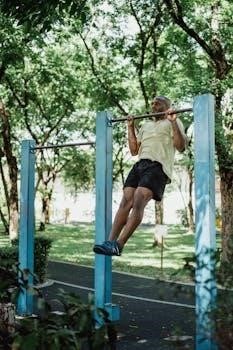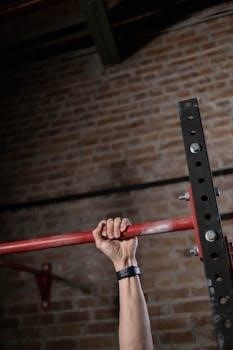Welcome to the world of pull-up training! This program is designed to help you achieve your first strict pull-up, with varied routines for all levels․ From beginner to advanced, we’ve got you covered․
Welcome to Pull-Up Training
Embark on your journey to mastering the pull-up! This program is meticulously crafted to guide individuals at every stage, from those just starting out to seasoned athletes․ We understand that everyone’s fitness path is unique, and our approach accommodates diverse skill levels․ Whether you’re aiming for your very first pull-up or looking to enhance your existing strength, we have the right resources for you․ Our comprehensive guide offers insights, exercises, and detailed plans designed to help you reach your goals․ We’ll explore various techniques, from beginner-friendly modifications to advanced variations, ensuring that you’re constantly challenged and progressing safely․ Get ready to transform your strength and fitness with our pull-up program!
Understanding Different Skill Levels
Our program caters to all, from beginner to advanced․ We’ll explore varied techniques and modifications to ensure optimal progress, regardless of your current fitness level․ Find your place!
Beginner Pull-Up Training
For beginners, mastering the pull-up starts with building foundational strength․ Focus on exercises like foot-assisted pull-ups, jumping pull-ups, and inverted rows․ These variations help develop the necessary muscles and movement patterns․ Chin-ups are also a great starting point for beginners, offering a more accessible grip․ It’s crucial to prioritize proper form over the number of repetitions․ Incorporating lat pulldowns and ring rows can further enhance your pulling strength․ Remember to listen to your body, and don’t hesitate to modify exercises as needed․ Consistent training with these beginner-friendly variations will set the stage for more advanced pull-up progressions․ Start slow, be patient, and celebrate the small victories along the way! Regular practice and dedication are key to success in pull-up training․
Intermediate Pull-Up Training
Intermediate pull-up training involves refining your technique and increasing the difficulty․ Focus on achieving full range of motion, pausing at the top and bottom of each rep․ Explore different grip styles, such as rotating between chin-ups and pull-ups every few months to promote joint health․ Slow tempo workouts can greatly enhance muscle engagement and control․ Consider adding weight to your pull-ups using a weight belt or weighted vest, if you can do more than 8-10 reps․ You can also integrate exercises like top holds and bar hangs to build static strength․ Aim to maintain consistent form and gradually progress the intensity․ If you are at this level, you can begin to vary your workouts and also focus on the quality of the reps․ This is where you will see your biggest jump in strength, so keep going!
Advanced Pull-Up Training
Advanced pull-up training is about pushing the boundaries of strength and control․ Here, you may begin to incorporate challenging variations, like chest-to-bar pull-ups or weighted pull-ups with significant added load․ Tempo training becomes more crucial; try super slow eccentrics to increase strength․ The pinnacle of pulling strength, the one-arm pull-up, becomes a goal to work towards․ Consider variations like L-sit pull-ups for core strength, and archer pull-ups to train unilateral strength․ The focus is now on maximizing power and developing advanced neuromuscular coordination․ Keep pushing the limits of your pull-up capacity․ This level requires a dedicated and consistent training regimen to achieve these advanced skills․ This is the point where you are the best of the best, keep going!

Pull-Up Program Structure
Our programs range from three to nine weeks, with a focus on gradual progression․ We offer structured plans, increasing reps and difficulty to help you master the pull-up․
Three-Week Pull-Up Program Example
This three-week program is designed to kickstart your pull-up journey․ It focuses on building a solid foundation․ Week one involves mastering the basics, such as assisted pull-ups or inverted rows, depending on your current level․ The second week includes increasing the volume and difficulty gradually․ We might add jumping pull ups or focus on more controlled negatives․ In the final week, we aim to test your progress and increase intensity slightly․ Remember, consistency is key, and it’s okay to adjust according to your strength․ This program will help you get closer to your first unassisted pull up, building strength and confidence․
Nine-Week Pull-Up Progression Program
Our nine-week pull-up progression program is designed for steady and sustainable progress, and it is not focused on strict pull-ups until the final week․ It gradually increases the difficulty over time, starting with foundational exercises like lat pulldowns and ring rows․ We recommend completing each exercise at least once a week․ The program also emphasizes proper form and controlled movements․ It builds strength and endurance․ Each week introduces new challenges, such as increased reps, sets, or more difficult variations․ This structure ensures you build the necessary strength gradually․ This method prevents injury and promotes long-term success in pull-up training․

Pull-Up Exercise Variations
Explore diverse pull-up variations, from beginner-friendly foot-assisted and jumping pull-ups, to intermediate and advanced options․ These variations cater to all skill levels and promote overall strength development․
Beginner Pull-Up Variations
For beginners, mastering the pull-up can seem daunting, but several variations can help build the necessary strength․ Foot-assisted pull-ups are a great starting point, where you use your feet to provide some support, reducing the overall weight you’re lifting․ Jumping pull-ups are another excellent option, utilizing momentum to get over the bar and focusing on the negative portion of the movement; These variations allow you to familiarize yourself with the pull-up motion and gradually increase your strength․ Another good exercise is bar hangs․ Focus on controlled movements, ensuring you do not use momentum to complete the movement․ Remember to keep your core engaged to maximize the effectiveness of these exercises․ It is important to maintain good form to prevent injuries․ As you get stronger you can start to reduce the assistance you use․
Intermediate Pull-Up Variations
Once you’ve mastered the basic pull-up, it’s time to explore intermediate variations․ These exercises will challenge your strength and help you progress further․ One great variation is the chin-up, which uses an underhand grip and often engages the biceps more․ Another effective exercise is the pull-up with a pause at the top, holding in the contracted position before lowering yourself․ This increases the time under tension and builds strength․ You can also experiment with different grip widths to target different muscle groups․ Remember to maintain proper form, focusing on controlled movements․ Rotating your grip style every few months is beneficial for joint health․ These variations will help you build a stronger base for advanced pull-up exercises․ Keep challenging yourself!
Advanced Pull-Up Variations
For advanced trainees, pull-up variations push the boundaries of strength and control․ Consider the archer pull-up, where you pull yourself to one side, engaging more of your lats and core․ Another demanding variation is the typewriter pull-up, where you move laterally from side to side at the top position․ Weighted pull-ups, using a weight belt or vest, add extra resistance and enhance strength gains․ The L-sit pull-up is a compound exercise, requiring core stability and strength․ Focus on maintaining perfect form․ Also consider explosive pull-ups, where you increase speed and power․ These advanced variations will challenge you to reach new levels of upper body strength․ These exercises are for advanced individuals․ Don’t forget to warm up before your workout!

Alternative Exercises
If pull-ups are too challenging, lat pulldowns and ring rows are excellent alternatives․ These exercises build similar muscle groups, developing strength needed for pull-ups․ Consider dumbbell rows for single-arm strength․
Lat Pulldowns and Ring Rows
Lat pulldowns are a fantastic alternative, especially for beginners․ They mimic the pull-up motion, allowing you to adjust the weight to your current strength level․ This exercise targets the latissimus dorsi muscles, crucial for pull-ups, and helps build the necessary foundation․ Ring rows, on the other hand, use bodyweight and a suspended set of rings, making it a scalable exercise for all levels․ They engage the back and biceps, promoting core stability simultaneously․ These two options are great for beginners to start building the strength and proper form for the more challenging pull-up․ Consistent practice with these alternatives will pave the way to eventually perform a full pull-up․ Additionally, you can incorporate single-arm dumbbell rows to further develop pulling strength․

Advanced Pulling Exercises
For those seeking the pinnacle of pulling strength, the one-arm pull-up stands as a supreme challenge․ This exercise requires immense strength, control, and full body engagement, making it a true test․
One-Arm Pull-Up
The one-arm pull-up represents the zenith of raw pulling strength, demanding exceptional control and full-body engagement․ This advanced exercise requires the ability to lift your entire body weight using just one arm․ It’s a true test of strength and stability, suitable only for highly experienced individuals․ It involves a full load of your body weight on one arm, making it a high-level pulling exercise․ It challenges not only the arm and back but also the core and grip strength․ Achieving this requires dedicated training, and a strong foundation in regular pull-ups is essential․ This exercise is a demonstration of peak physical performance․ Proper form is crucial to prevent injury, and it should not be attempted until a solid base is established․ It is the ultimate goal for many pull-up enthusiasts, symbolizing incredible upper body power․
Additional Considerations
To enhance your pull-up training, consider incorporating tempo training․ This involves controlling the speed of each phase, increasing time under tension and improving muscle engagement for better results․
Tempo Training in Pull-Ups
Tempo training is a crucial element in pull-up progression, especially for intermediate to advanced individuals․ By controlling the speed of each repetition, you significantly increase the time muscles are under tension․ This method enhances muscular endurance and strength․ For instance, a 3-1-2-1 tempo indicates a 3-second lowering (eccentric) phase, a 1-second pause at the bottom, a 2-second upward (concentric) phase, and a 1-second pause at the top․ This deliberate approach maximizes muscle activation and force development․ Beginners should focus on mastering the standard pull-up first before implementing tempo variations․ Incorporating this technique will lead to better results and overcome plateaus․ It’s a great way to challenge yourself!